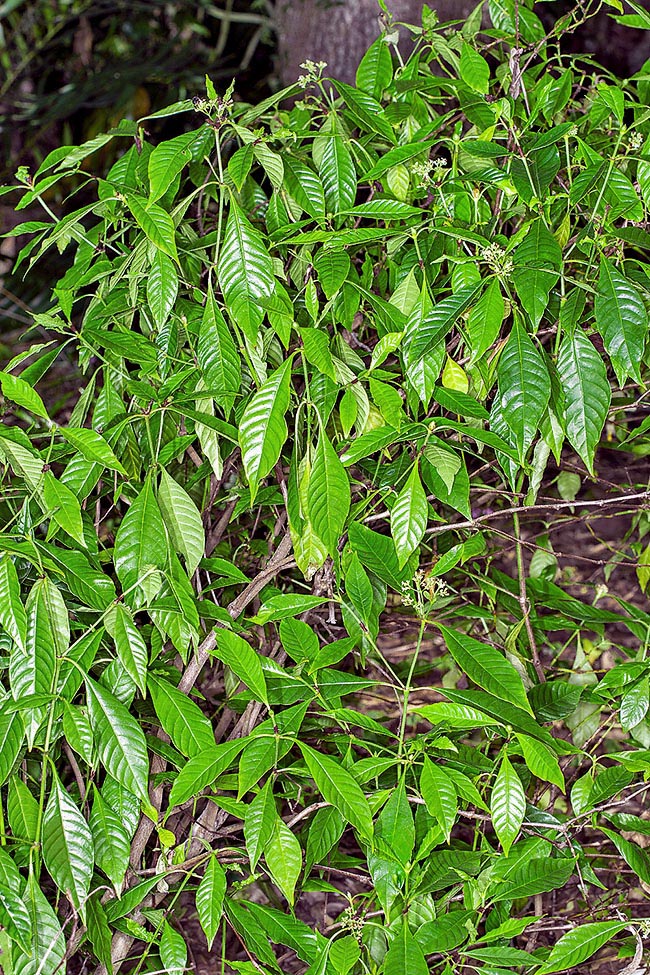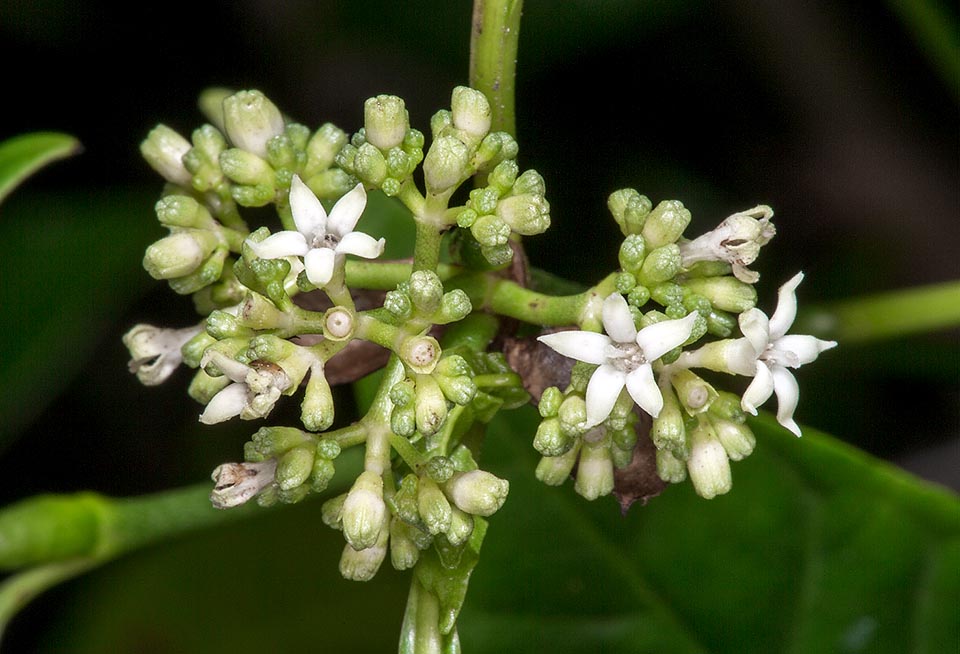Family : Rubiaceae

Text © Pietro Puccio

English translation by Mario Beltramini

The Psychotria tenuifolia is a compact evergreen shrub of tropical America © Giuseppe Mazza
The species is native to Belize, Bolivia, Brazil (Espirito Santo, Minas Gerais, Rio de Janeiro, São Paulo and Trindade), Colombia, Costa Rica, Cuba, Dominican Republic, Ecuador, El Salvador, Guatemala, Haiti, Honduras, Jamaica, Leeward Islands, Mexico (Aguascalientes, Campeche, Chiapas, Coahuila, Chihuahua, Durango, Guanajuato, Guerrero, Hidalgo, Jalisco, México Distrito Federal, México, Michoacán, Morelos, Nayarit, Nuevo León, Oaxaca, Puebla, Querétaro, Quintana Roo, San Luis Potosí, Tabasco, Tamaulipas, Tlaxcala, Veracruz, Yucatán and Zacatecas), Nicaragua, Panama, Peru, Puerto Rico, USA (Florida) and Venezuela where it grows in the underwood of the humid forests usually on calcareous soils, from the sea level up to about 1700 m of altitude.
The exact derivation of the generic name is unknown, probably is the combination of the Greek substantives “ψυχή” (psyché) = breath, life force, life and “ἰατρεία“ (iatreia) = healing, due to the supposed healing properties of some species; the specific name is the combination of the Latin adjective “tenuis, e” = thin, small and of the substantive “folium, ii” = leaf.
Common names: dog’s tongue, shortleaf wild coffee, velvet-leafed wild coffee, wild coffee (English); lengua de perro (Spanish).
The Psychotria tenuifolia Sw. (1788) is a compact evergreen shrub with fairly slow growth, up to 3 m tall, but that usually does not exceed the 0,4-0,5 m.
The leaves, on a 0,5-4 cm long petiole, are opposite, oblanceolate to elliptic-lanceolate with acuminate apex, entire margin and marked veins, 7-16 cm long and 2,5-6 cm broad, of opaque dark green colour with velvety hues above, pubescent below.
Terminal panicle inflorescences, 1,8-2,4 cm long, bearing numerous sessile hermaphrodite flowers, of about 4 mm of diameter, white or greenish white. Calyx, about 1 mm long, with 5 triangular lobes, pubescent, infundibuliform corolla pubescent outside with about 2 mm long tube, 5 ovate lobes with acute apex, 1,5-2,5 mm long, slightly prominent stamens and about 3 mm long style. The fruits are ovoid berries, 4-6 mm long, orange or of red colour when ripe, containing one ovoid seed 3-4 mm long.
Shrub versatile and easy to cultivate, it can grow in full sun as well as in complete shade and stands well the saline winds, therefore it can be utilized as soil cover in an ample variety of situations in the tropical, subtropical climates and marginally in the temperate-warm ones, where temperatures slightly lower than 0 °C are short lasting exceptions.

Inflorescences with 4 mm of diameter corollas. Leaves and flowers in mush are employed in the traditional medicine © Giuseppe Mazza
It is not particularly demanding about the soil, provided draining, even if it prefers the sandy calcareous ones maintained almost constantly humid, but well rooted it may stand short dry periods.
Leaves and flowers in mush are utilized in the traditional medicine by some populations to heal wounds, rashes, swellings and infected sores.
Synonyms: Psychotria laurifolia Bertol. ex DC. (1830); Psychotria sessilifolia M.Martens & Galeotti (1844); Uragoga sessilifolia (M.Martens & Galeotti) Kuntze (1891); Uragoga tenuifolia (Sw.) Kuntze (1891); Psychotria pulverulenta Urb. (1913); Psychotria sulzneri Small (1913).
→ To appreciate the biodiversity within the RUBIACEAE family please click here.
